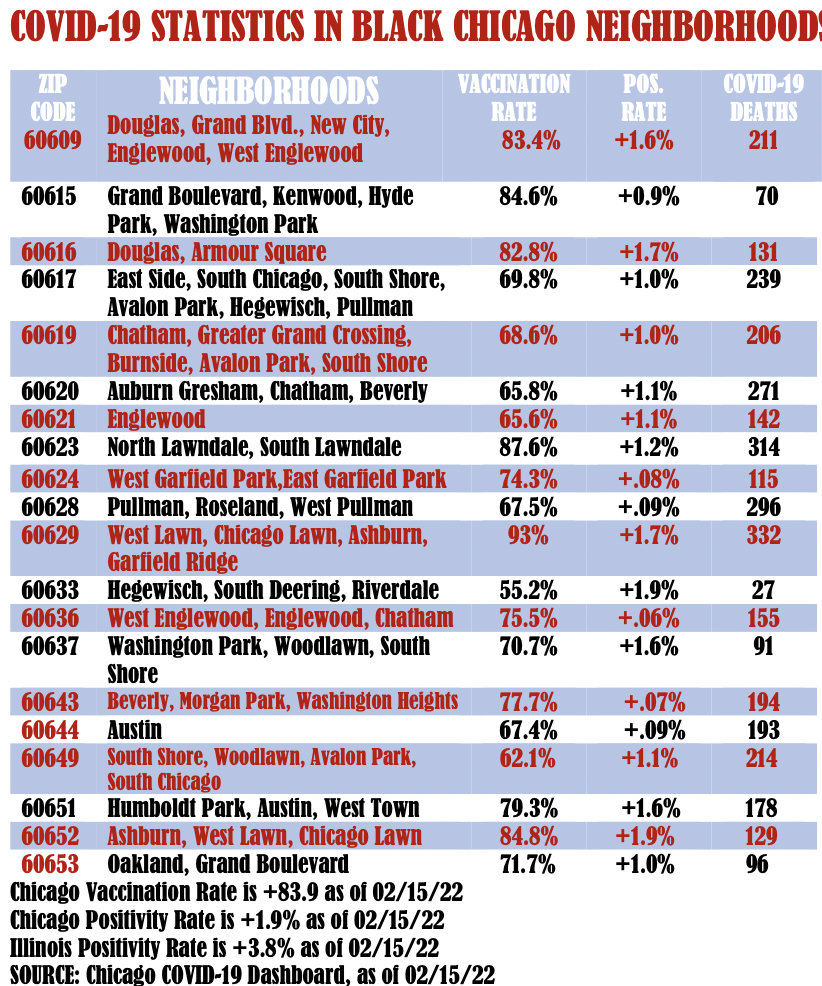The Omicron surge continues to decline as all of Chicago’s 20 Black zip codes have positivity rates below the city average, according to a Crusader analysis of data from the city’s COVID-19 dashboard.
As of February 15, the city’s positivity rate dipped to 1.9 percent, the lowest since July 17, when the positivity rate was 1.3 percent.
All 20 Black zip codes have positivity rates that range from .06 percent to 1.9 percent, public health data show. In the previous week that ended February 8, 19 of 20 Black zip codes had positivity rates below the city’s average, which was then 2.9 percent.
Zip code 60633, which includes Hegewisch and parts of Riverdale, had a positivity rate of 3.2 percent. The latest figure as of February 15 shows a 1.9 percent positivity rate.
The number of COVID-19 deaths is nearly twice as low as the previous week, but the casualties remain a concern as the Omicron surge continues to decline. A total of 39 people died over a one-week period from February 8 to February 15, according to Crusader calculations of the latest figures from the Chicago Department of Public Health.
The previous week saw 62 COVID-19 deaths in the 20 Black zip codes. For the one-week period ending February 1, there were 159 deaths in those zip codes.
The latest figures from February 15 show that seven people died of the disease in zip code 60609, which includes Douglas, Grand Boulevard, New City, Englewood and West Englewood. Another seven died in zip code 60623, which includes North Lawndale and South Lawndale. Three zip codes had no COVID-19 deaths that week.
Governor JB Pritzker announced last week that Illinois’ statewide mask mandate is set to end February 28 if the state’s COVID-19 metrics continue to fall. Chicago health officials announced that it would end its mask and proof of vaccination mandates if the city hits three out of four milestones for at least two weeks.
So far, Chicago has met one of its goals, which is achieving a positivity rate lower than 4.9 percent.
“We’re going to see where we are next week and make a decision sort of either way there,” said Chicago Department of Public Health Commissioner Allison Arwady. “If we are not able to move on the 28th, I think it would probably be not very long after that.”
The following are the state’s goals for ending the mandate and where Chicago stands with each:
• Cases: Chicago must report an average of 199 cases or fewer per day. The city now has an average of 431 cases per day.
• Positivity rate: Chicago’s positivity rate must be at 4.9 percent or lower. It’s at 1.9 percent as of February 15.
• Hospital beds: Chicago must have an average of 249 or fewer beds occupied by COVID-19 patients per day. The city is averaging 376 occupied beds per day.
• ICU beds: Chicago must have an average of 99 or fewer ICU beds occupied by COVID-19 patients per day. So far, the average is 115 per day.
Arwady said Chicago has a chance to meet ICU beds goal this week. She also expects Chicago to achieve its goal for non-ICU hospital beds shortly after. That would leave just one goal left for the city to meet, which is 199 cases or fewer per day.
“Given the progress we are making, I am feeling very optimistic,” Arwady said.
Arwady said the city would end its two-week wait and end its mandate if Chicago remains on pace to achieve its goals. She said as the state mandate ends, it wouldn’t be worth confusing residents to continue the mandates, so long as Chicago has hit at least three of its goals and numbers are declining.
“I will be honest with you: We need to hit those metrics to feel confident,” Arwady said. “I want people to understand we’re not just choosing a date; we’re going based on when we’re there.”






